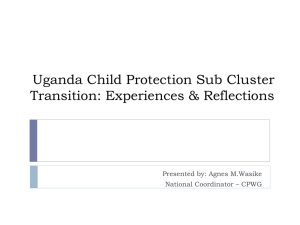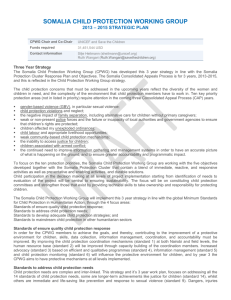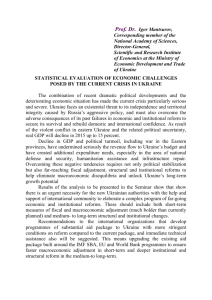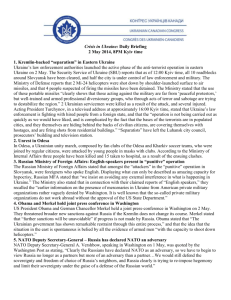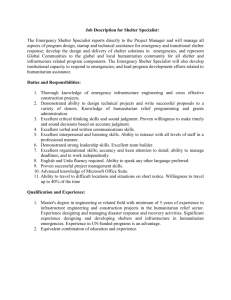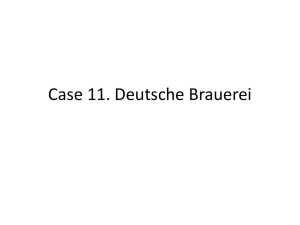ToR CPWG Draft vs1
advertisement
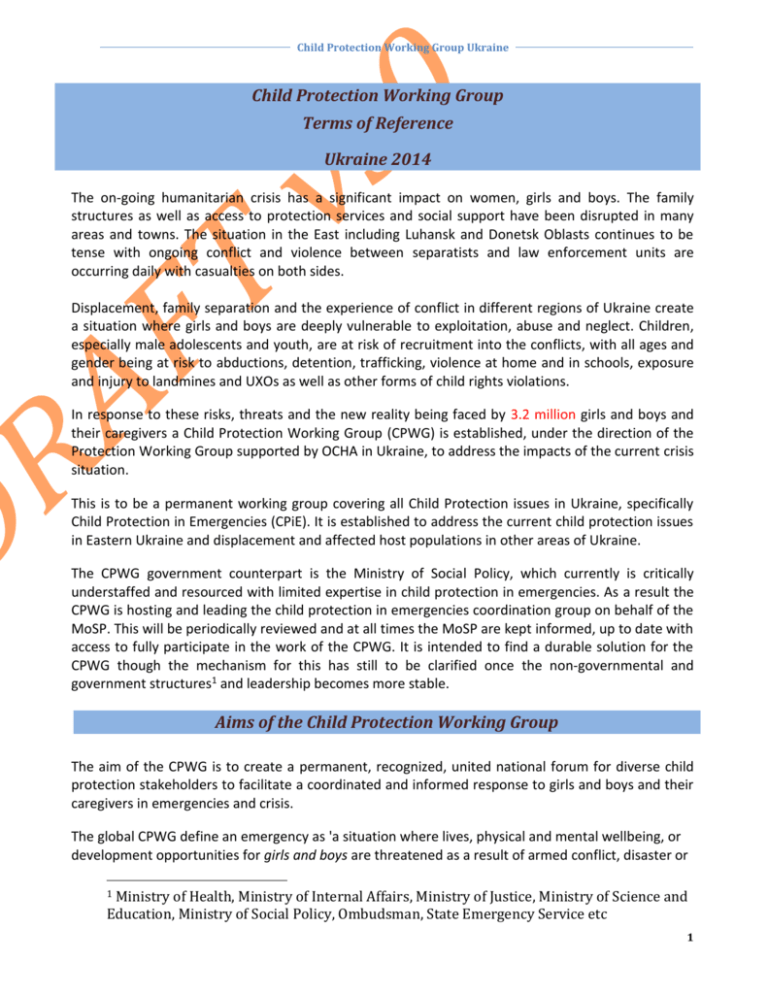
Child Protection Working Group Ukraine Child Protection Working Group Terms of Reference Ukraine 2014 The on-going humanitarian crisis has a significant impact on women, girls and boys. The family structures as well as access to protection services and social support have been disrupted in many areas and towns. The situation in the East including Luhansk and Donetsk Oblasts continues to be tense with ongoing conflict and violence between separatists and law enforcement units are occurring daily with casualties on both sides. Displacement, family separation and the experience of conflict in different regions of Ukraine create a situation where girls and boys are deeply vulnerable to exploitation, abuse and neglect. Children, especially male adolescents and youth, are at risk of recruitment into the conflicts, with all ages and gender being at risk to abductions, detention, trafficking, violence at home and in schools, exposure and injury to landmines and UXOs as well as other forms of child rights violations. In response to these risks, threats and the new reality being faced by 3.2 million girls and boys and their caregivers a Child Protection Working Group (CPWG) is established, under the direction of the Protection Working Group supported by OCHA in Ukraine, to address the impacts of the current crisis situation. This is to be a permanent working group covering all Child Protection issues in Ukraine, specifically Child Protection in Emergencies (CPiE). It is established to address the current child protection issues in Eastern Ukraine and displacement and affected host populations in other areas of Ukraine. The CPWG government counterpart is the Ministry of Social Policy, which currently is critically understaffed and resourced with limited expertise in child protection in emergencies. As a result the CPWG is hosting and leading the child protection in emergencies coordination group on behalf of the MoSP. This will be periodically reviewed and at all times the MoSP are kept informed, up to date with access to fully participate in the work of the CPWG. It is intended to find a durable solution for the CPWG though the mechanism for this has still to be clarified once the non-governmental and government structures1 and leadership becomes more stable. Aims of the Child Protection Working Group The aim of the CPWG is to create a permanent, recognized, united national forum for diverse child protection stakeholders to facilitate a coordinated and informed response to girls and boys and their caregivers in emergencies and crisis. The global CPWG define an emergency as 'a situation where lives, physical and mental wellbeing, or development opportunities for girls and boys are threatened as a result of armed conflict, disaster or Ministry of Health, Ministry of Internal Affairs, Ministry of Justice, Ministry of Science and Education, Ministry of Social Policy, Ombudsman, State Emergency Service etc 1 1 Child Protection Working Group - Ukraine the breakdown of social or legal order, and where local capacity (governmental and nongovernmental) to cope is exceeded or inadequate'. The basis of work of the CPWG will be to have consensus, to use international standards and good practices, ensure minimum standards, standardization, support community mobilization, information sharing, monitoring, advocacy, budgets, donors, the representation of CP issues in other forums and accountability. The CPWG will draft a strategy, annual work plans, budgets, and timeframes to represent its work on behalf of children and their caregivers. This will include cross-sectorial issues, Emergency Preparedness and Response Plans, Contingency Planning and Early Recovery/Transition planning. The work of the CPWG will reflect the principles and processes of the IASC Transformative Agenda. A core component of the CPWG work will be capacity building, professional development and awareness raising of key child protection stakeholders including state, non-government and community representatives. The CPWG will work to be integrated and embedded as a national inter-ministry structure to be able to fully take the lead, direction and future development of this issues of children and to be able to effectively respond to child protection issues in emergencies, crisis, transitioning and early recovery. Roles and Responsibilities Within this framework, the CPWG will be responsible for the following: 1. Coordination A. Planning and programming for girls, boys and caregivers shall be coordinated with government counterparts and other relevant authorities, non-state actors, (I)NGOs, civil societies, faith based agencies and donors, ensuring that meetings and response by CPWG are consultative, participatory and results-oriented, applying the five principles of partnership, namely: Equality – with partners respecting each other’s mandates, obligations and independence and recognizing each other’s constraints and commitments. Transparency – with emphasis on early consultations and early sharing of information Results-oriented approach – being reality-based and action-oriented Responsibility – committing to activities when partners have means, competencies, skills and capacity to deliver on their commitments Complementarity – building on comparative advantages and complementing on each other’s contributions. B. The CPWG shall provide transparent strategic direction and develop a child protection strategy and work plan to represent the consensus of the CPWG members and the needs and issues of girls, boys and caregivers affected by the conflict (reflecting the IASC Transformative Agenda 2 Child Protection Working Group Ukraine principles and processes2). C. The CPWG is a sub-sector of the Protection Sector, where the group’s objectives and actions are coordinated with actions of the Protection Sector and among intra-sector collaboration and cooperation. D. The aim of the coordination is to reduce overlap, address gaps and provide solutions and information to identified problems/gaps. 2. Assessment, surveys, inventory of response capacity and resource mobilization The CPWG shall analyze trends and risks faced by children and caregivers in the context of the conflict both in directly affected communities and for IDPs in other regions of Ukraine. Coordinate and support child protection assessments and/or participate in assessment processes at the Protection or other Inter-sector levels Map child protection actors and their programmatic and geographic areas using the 5W global mapping tool3, assessing all critical gaps, vulnerabilities and information on who is doing what, where, when and how to address these outstanding needs and to ensure all priority child protection needs are addressed in an adequate and timely manner Establish a database of child protection practitioners (master Participants list) available for supporting activities and interventions in favor of children and women. Actively advocate to donor partners for funding to support under-resourced child protection intervention initiatives, particularly for local NGOs and community-based organizations Actively advocate to government partners for policy and legislative support in meeting the needs of children and addressing issues that negatively impact their heath and wellbeing 3. Information Management, Monitoring and Reporting The CPWG shall facilitate information exchange on child protection needs and new developments as well as monitoring and reporting on grave violations of children in conflict and other serious protection concerns regarding children, women and caregivers. Facilitate reporting and information sharing within the sub-sector and at the protection sector and inter-sector level Ensure that the CPWG has a functional information management strategy and mechanism Contribute to UN updates and briefings on protection concerns for children and women in the affected areas, response activities, challenges and recommendations for the Humanitarian Coordinator, Humanitarian Country Team and other stakeholders Facilitate regular flow of information from local to central and vice versa Coordinate child protection aspects of rapid and longer-term assessments Monitor trends and early warning indicators and ensure emergency preparedness planning is http://www.humanitarianinfo.org/iasc/pageloader.aspx?page=content-templatedefault&bd=87 2 3 Global CPWG 5W: who – what – where – when – why 3 Child Protection Working Group - Ukraine carried out, in order to anticipate new child protection risks and pre-position a response Evaluate and adapt actions on ongoing basis Support the OCHA Humanitarian Situation Monitoring (HSM) mechanism 4. Standards Setting and Implementation The CPWG shall provide a coordination forum for child protection activities that provide guidance to all partners on common standards, strategies and approaches. The CPWG shall implement standard operating procedures when and where necessary to facilitate the response to the crisis and to ensure that the international standards, humanitarian principles and international procedures for children affected by the conflict are appropriately adapted, respected and used for responses in Ukraine. The CPWG shall maintain the child protection profile within the broader protection structure and ensure mainstreaming of child protection in other humanitarian sectors (including OSCE and OHCHR monitoring in Ukraine). Coordinate the integration of cross-cutting issues in the work of the CPWG such as women, adolescents, elderly, GBV, PSS, ethnic minorities (Roma) Ensure adherence of the CPWG activities to guidelines on age, gender and diversity mainstreaming 5. Advocacy. Develop an advocacy strategy for issues related to child protection, involving participation of state and non-state partners across sectors. Identify core advocacy concerns for child protection through a consultative process: joint subsector/ inter-sector initiatives to ensure regular and consistent advocacy Establish coordinated children protection messages for children and the community (e.g. importance of psycho-social support/ how to address distress for children/ families; importance of UXO, prevention and response UASC4, legal issues etc.) Contribute to Protection sector’s adherence to international humanitarian law and international human rights instruments, the Guiding Principles on Internal Displacement as well as other relevant international and regional instruments Promote and support strengthening of national legislation and normative provisions relevant to internal displacement and durable solutions Membership The CPWG is open to all child protection actors and stakeholders5 who uphold minimum standards and good practices6 in the delivery of relevant and appropriate child protection social and legal services in emergencies and crisis. 4 Unaccompanied and separated children Ministry of Social Policy (lead), Ministry of Education and Science, Ministry of Health, Ministry of Justice, Ministry of Internal Affairs, Penitentiary Services, Office of the Human Rights Ombudsperson, Office of the Presidential Commissioner on Child Rights, other relevant Government bodies and local government administrations, NGOs, INGOs, faith based and civil societies, UN Agencies 6 As defined by the CPWG 5 4 Child Protection Working Group Ukraine Working Groups, Task Forces, Committee’s may further define the structure of the CPWG as needs are identified and priorities and issues clarified. Sessions and Reporting It is important to have the CPWG coordination mechanisms as close to the affected populations as possible. This ensures real time cohesion, consistency and updates to best prevent and respond to child protection issues. This means the ‘main’ CPWG coordination meetings may be ‘in the field’ with the national level CPWG coordination structure acting as support. An example is national CPWG can focus on policies, SoPs, advocacy, fund raising, etc while the field CPWG coordination can focus on monitoring, community mobilization, training. If several CPWG coordination ‘hubs’ are needed than a roving CPWG coordination may be a mechanism to consider or variations thereof. The CPWG will meet regularly enough to ensure the needs of girls and boys and their caregivers are met as expediently as possible. All meetings are to be announced in advance with agenda and minutes documented. Currently the CPWG will report to the Protection Sector, the CPWG will also ensure relevant national bodies receive copies of information and documentation. Confidentiality and Documentation The CPWG is not meant to serve as a forum for discussion on individual cases. In the event that individual cases of abuse, exploitation or violence against children or their caregivers are discussed these must be treated with absolute confidentiality. Detailed documentation related to individual protection cases shall not be shared in meetings. Glossary CPiE - Child Protection in Emergencies - The CPWG defines child protection in emergencies (CPiE) as “the prevention of and response to abuse, neglect, exploitation of and violence against children in emergencies.” This contrasts with the Inter Agency Standing Committee (IASC) definition of protection, which includes all human rights. In practice, child protection work includes specific programs run by child protection specialists, as well as actions integrated into all other humanitarian sectors. CP – Child Protection - is a set of usually government-run services designed to protect children and young people who are underage and to encourage family stability. CPWG – Child Protection Working Group - The Child Protection Working Group (CPWG) is the global level forum for coordination and collaboration on child protection in humanitarian settings. The group brings together NGOs, UN agencies, academics and other partners under the 5 Child Protection Working Group - Ukraine shared objective of ensuring more predictable, accountable and effective child protection responses in emergencies. GBV – Gender Based Violence - is violence that is directed against a person on the basis of gender. It constitutes a breach of the fundamental right to life, liberty, security, dignity, equality between women and men, non-discrimination and physical and mental integrity. HSM - Humanitarian Situation Monitoring – is a process to inform planning for immediate response and for adequate preparedness measures. IASC - Inter- Agency Standing Committee - is the primary mechanism for inter-agency coordination of humanitarian assistance. It is a unique forum involving the key UN and non-UN humanitarian partners. (I)NGO- International Non-Governmental Organization - has the same mission as a nongovernmental organization (NGO), but it is international in scope and has outposts around the world to deal with specific issues in many countries. MoSP - Ministry of Social Policy(of Ukraine) - is the Ukrainian department responsible for instituting policy regarding a broad range of social issues in the country. Specifically, these issues are labor relations, family and children, immigration and trafficking, women's rights, children's rights, and humanitarian aid. NGO- Non-Governmental Organization - is the term commonly used for an organization that is neither a part of a government nor a conventional for-profit business. OCHA - (United Nations) Office for the Coordination of Humanitarian Affairs - is the part of the United Nations Secretariat responsible for bringing together humanitarian actors to ensure a coherent response to emergencies. OCHA also ensures there is a framework within which each actor can contribute to the overall response effort. OHCHR - Office of the High Commissioner for Human Rights - is a United Nations agency that works to promote and protect the human rights that are guaranteed under international law and stipulated in the Universal Declaration of Human Rights of 1948. OSCE – Organization for Security and Cooperation in Europe - is the world's largest security-oriented intergovernmental organization. Its mandate includes issues such as arms control and the promotion of human rights, freedom of the press and fair elections. PSS – Psychosocial - means it relates to one's psychological development in, and interaction with, a social environment. SoP – Standard Operating Procedures - Established procedures to be followed in carrying out a given operation or in a given situation. UASC – Unaccompanied and Separated Children 6 Child Protection Working Group Ukraine Separated children are those separated from both parents, or from their previous legal or customary primary care-giver, but not necessarily from other relatives. These may, therefore, include children accompanied by other adult family members. Unaccompanied children (also called unaccompanied minors) are children who have been separated from both parents and other relatives and are not being cared for by an adult who, by law or custom, is responsible for doing so. UN – United Nations - is an intergovernmental organization established 24 October 1945, to promote international co-operation. A replacement for the ineffective League of Nations, the organization was created following the Second World War to prevent another such conflict. UXO - Unexploded Ordnance - are explosive weapons (bombs, shells, grenades, land mines, naval mines, etc.) that did not explode when they were employed and still pose a risk of detonation, potentially many decades after they were used or discarded. Vulnerability - can be defined as the diminished capacity of an individual or group to anticipate, cope with, resist and recover from the impact of a natural or man-made hazard. The concept is relative and dynamic. Vulnerability is most often associated with poverty, but it can also arise when people are isolated, insecure and defenceless in the face of risk, shock or stress. 7
